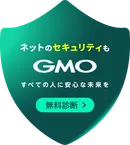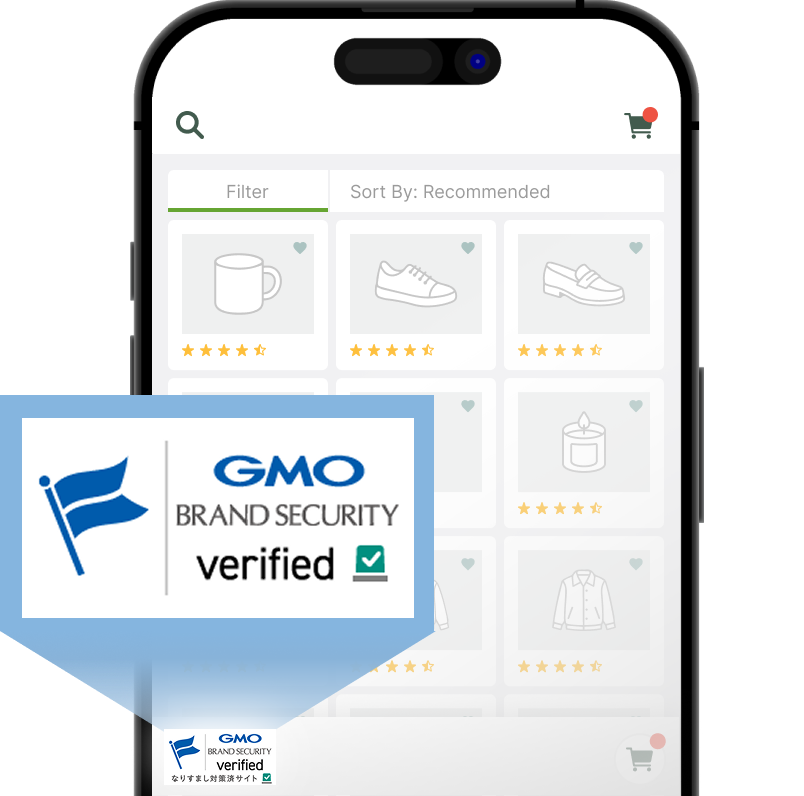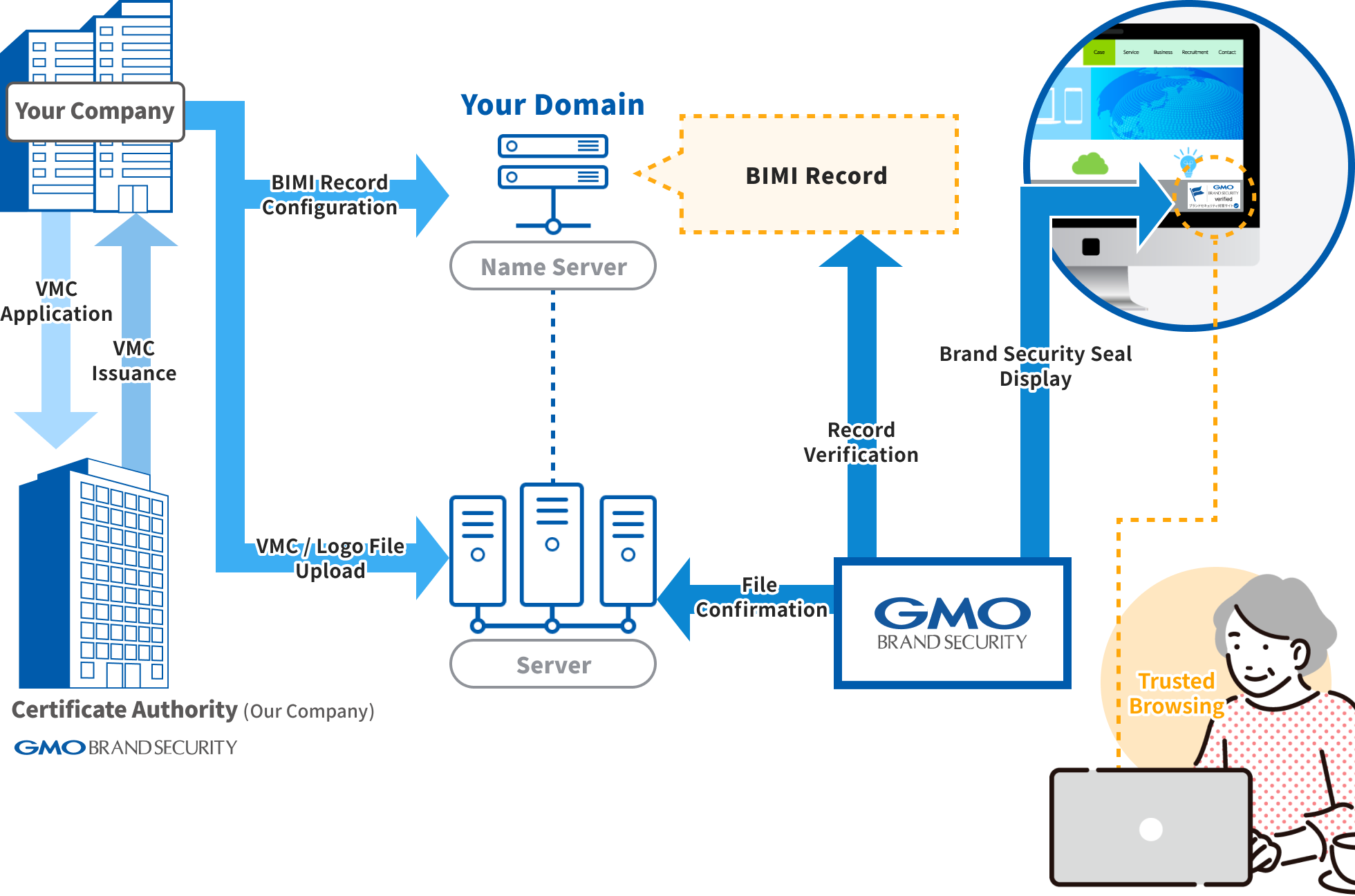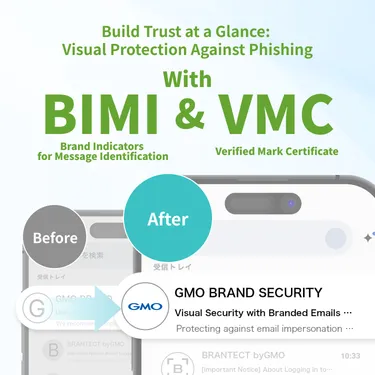Media Coverage
- Our GMO Anti-Spoofing Seal was featured in an article in Yomiuri Shimbun (October 3, 2024), titled "Official Site Proof: GMO Banner for Anti-Spoofing Measures."
What is GMO Anti-Spoofing Seal?
GMO Anti-Spoofing Seal certifies that a website is operated under proper authority by verifying (1) the existence of the site operator, (2) domain authentication, and (3) trademark verification.
It proves the legitimacy of using brand marks, something that SSL/TLS cannot authenticate. GMO Anti-Spoofing Seal uses Verified Mark Certificate (VMC) technology, which is also adopted in BIMI (Brand Indicators for Message Identification).
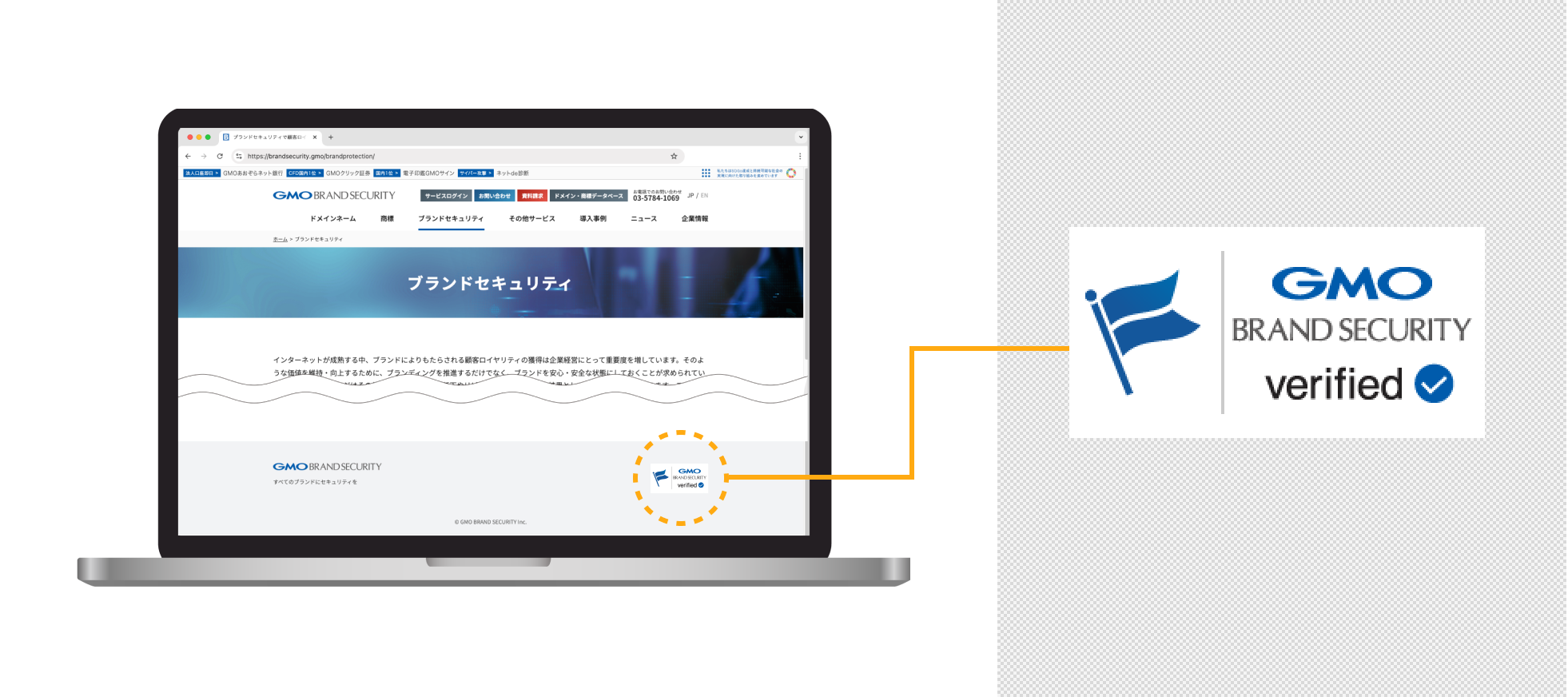
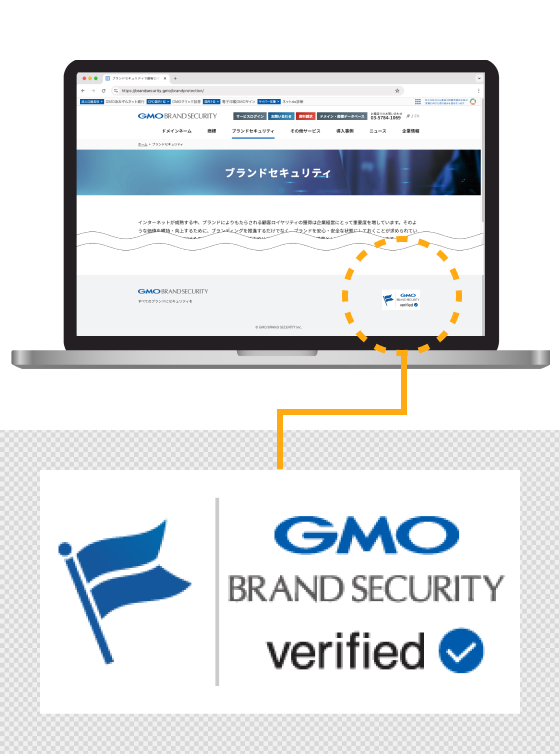
Why is GMO Anti-Spoofing Seal Necessary?
Over the past quarter century, the internet has become essential as digital infrastructure. However, alongside its convenience, it has been exploited for brand infringement issues such as impersonation, phishing, counterfeit product sales, and brand free-riding.
It has become increasingly difficult for users to determine if a website is genuine.
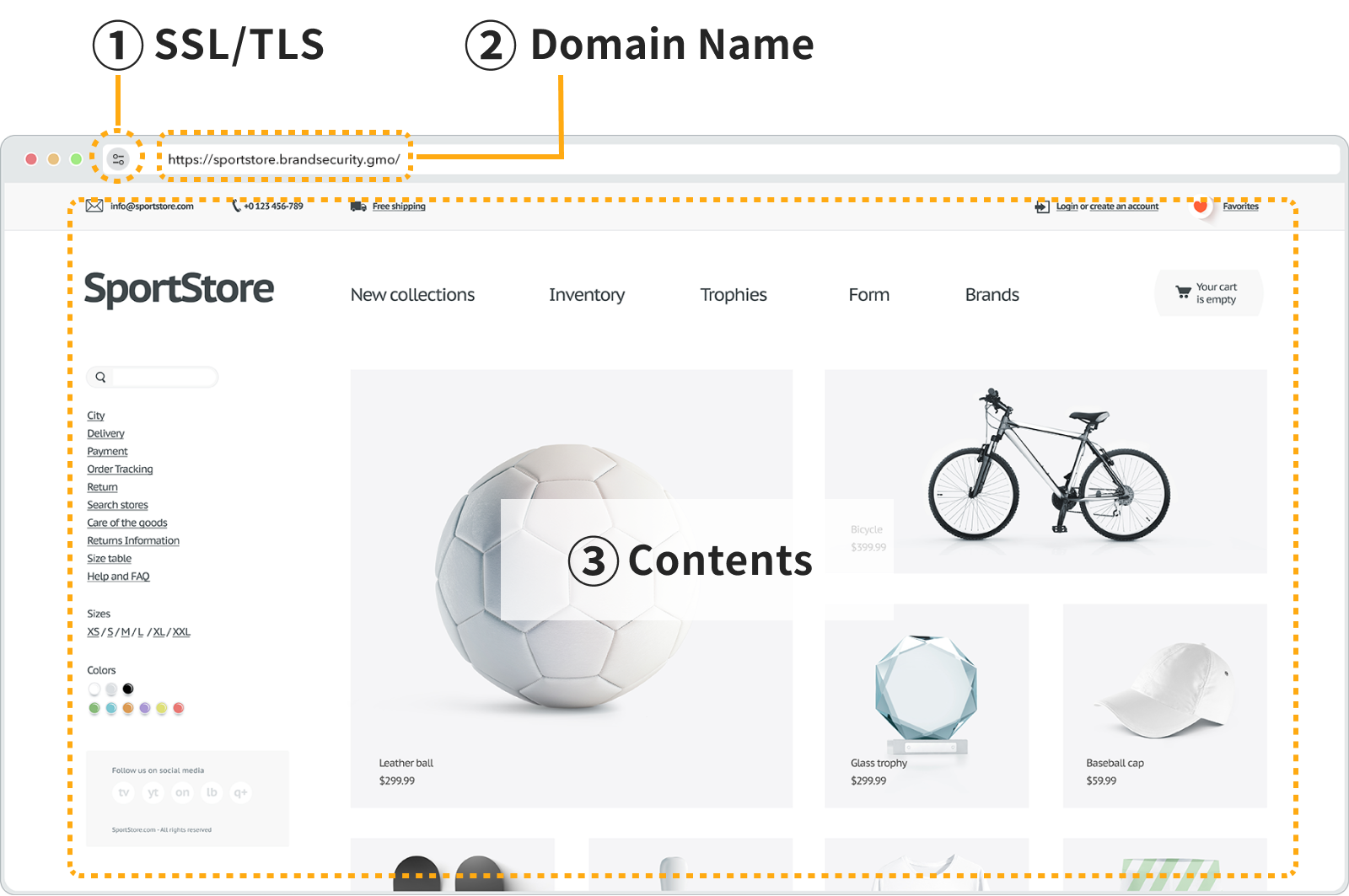
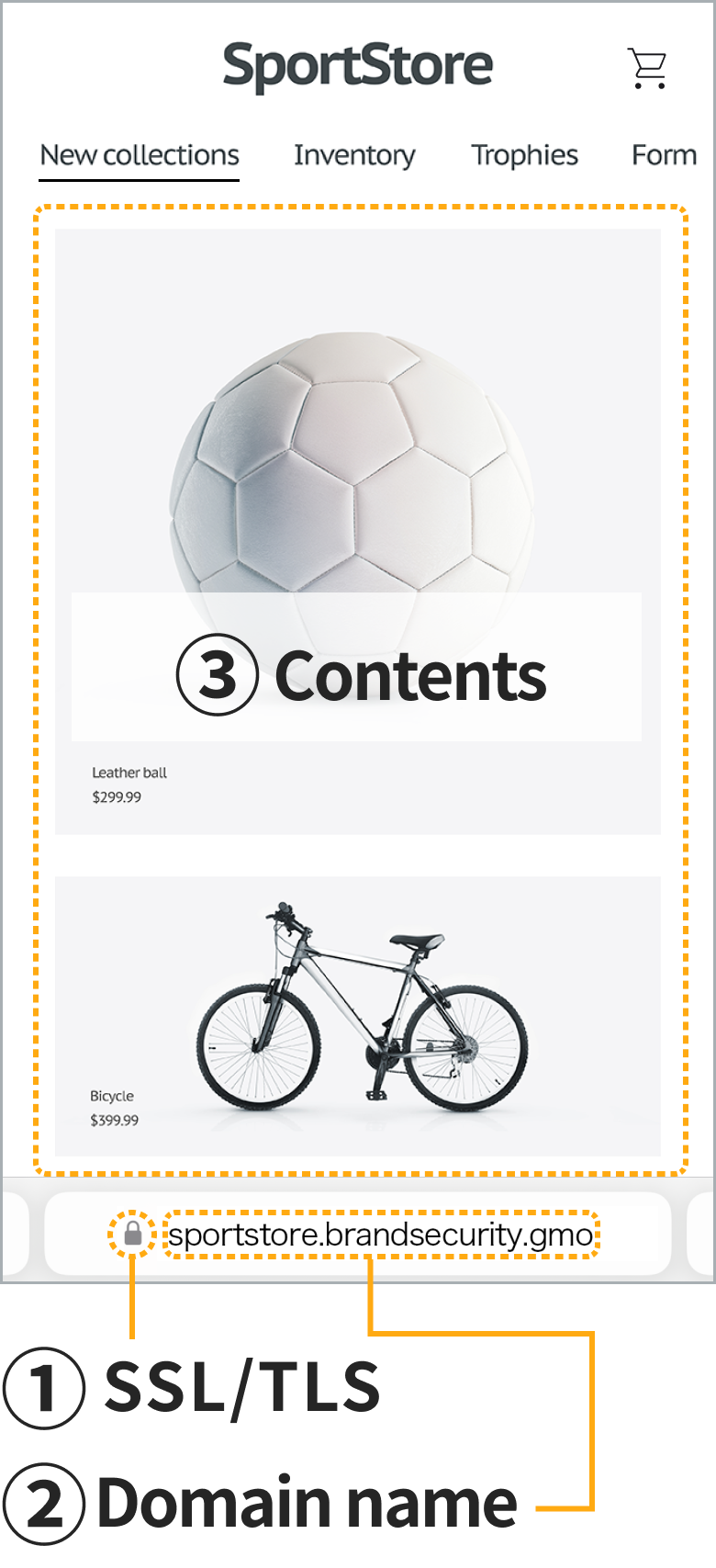
① SSL/TLS
One of the methods to verify website operators, SSL/TLS, is increasingly preferred without verifying the operator’s existence due to cost considerations, making it difficult to confirm the operator's identity.
② Domain Name
Domain Whois information has been increasingly privatized following the enforcement of the EU’s General Data Protection Regulation (GDPR), which classifies it as personal information, making ownership verification challenging.
③ Contents
Website content is created by the operator and is not authenticated by a third-party authority. Moreover, it is easy to copy.
A secure and reliable environment where users can access websites with confidence is required.
Effectiveness of GMO Anti-Spoofing Seal
GMO Anti-Spoofing Seal certifies that a website is operated under proper authority by verifying the existence of the operator, the domain, and the trademark through a Certificate Authority. In addition to EV SSL-level verification, the content’s trustworthiness is also ensured through trademark authentication.

Anti-Spoofing and
Phishing Measures
Existence verification involves a strict review process that includes not only document checks but also face-to-face interviews.

Anti-Counterfeiting Measures
Trademark authentication proves that the brand mark is being used by the rightful owner.

License Certification
The seal can also be used to certify licensing when a company is authorized to use a brand through an agency or another third party.
Terms of Use
Condition 1Trademark Registration for Brand Mark
The trademark to be certified must be a registered trademark. As a general rule, the certified trademark must match the brand mark displayed on the website. Additionally, there is no issue if the registered trademark is from a country or region belonging to the World Intellectual Property Organization (WIPO). The classification and designated goods or services do not matter.
Condition 2Apply for VMC
To apply for a VMC, you will need to provide application information and various documents.
- Specify the domain name to be authenticated.
- Prepare the registered trademark information to be authenticated. If you are licensed to use the trademark, you will need to obtain a usage permission letter from the registered trademark owner.
- Prepare the logo file (SVG Tiny 1.2 version).
Please refer to https://support.google.com/a/answer/10911027?hl=en&sjid=18281942727403524387-AP for the file settings. - Prepare registry documents to prove you are the site operator. Below is a list of key documents:
- Certified copy of the company registry (Certificate of all current matters)
- Balance certificate
- Tax certificates for the last 3 years
- Invoice from a telephone company
- Certificate of Employment for the Contract Signatory and Certificate Approver
- Identification Document of the Contract Signatory or Certificate Approver
Condition 3Review
The review process involves domain, organizational, and trademark verification, similar to the EV SSL validation in SSL/TLS, with the addition of trademark verification.
- Domain name Verification
- Operator Existence Authentication
- Trademark Authentication
This verifies that the domain name is being used by its legitimate owner. The verification can be done by either approving an authorization email sent to the domain’s public email address or by adding a specific string issued by the certification authority to the DNS.
This process confirms the existence of the organization and the authority of those involved in its operation. In addition to objective information, this verification may include phone calls or interviews to assess the organization’s legitimacy.
This ensures that the brand logo (SVG file) matches the trademark registration. The trademark must be registered in a country or region that is a member of the World Intellectual Property Organization (WIPO). The classification and designated goods of the trademark do not matter, but the brand logo must match the registered trademark. If the logo differs from the registered trademark (e.g., a standard character mark), a trademark application may be required.
Condition 4VMC Issuance
The VMC is issued by the certification authority in PEM file format. A PEM (Privacy Enhanced Mail) file is a file format used primarily for storing digital certificates or private keys for encryption and authentication purposes.
Condition 5GMO Anti-Spoofing Seal usage setup
The process for setting up BIMI is as follows:
- Upload the PEM file and the brand logo (in SVG format).
- Enter the BIMI record.
The PEM file and brand logo (in SVG format) should be uploaded to the designated location.
It is required that the URL be static.Next, configure the BIMI record as follows:Example:
- https://www.〇〇.co.jp/bimi/vmc/〇〇.pem
- https://www.〇〇.co.jp/bimi/logo/〇〇_logo.svg
By using the https://bimigroup.org/bimi-generator/, you can create it accurately.Field Value Description Type TXT DNS Record Type Host Valuedefault._bimi.[Verified Domain] DescriptionPlease enter the verified domain after "default._bimi.". Value ValueV=BIMI1; l=[URL of the SVG file]; a=[URL of the PEM file] DescriptionThis is your BIMI record TTL Value3600 seconds DescriptionSet it to 1 hour
To display GMO Anti-Spoofing Seal on your website, please implement GMO Anti-Spoofing Seal logo and setup program provided by our company.
By installing GMO Anti-Spoofing Seal,
users can confidently use your services.
As a result, companies can enhance the trustworthiness of their brand.
Why you should choose 
Trademark Services with 20 Years of Experience
GMO BRAND SECURITY has extensive expertise in trademarks. You can confidently rely on us for the crucial trademark verification needed for VMC issuance.
The root certificate authority is GlobalSign, the largest SSL/TLS provider in Japan
With GlobalSign, part of the GMO Internet Group, acting as the root certificate authority, stable BIMI operations are possible with all email vendors.
We also provide additional services such as brand infringement monitoring
We also offer solutions in case of brand infringement or cybersecurity risks. (Examples: brand infringement monitoring, site takedown, vulnerability assessment).
Our experienced staff designs solutions tailored to your company's specific challenges
We work with 2,000 companies, primarily large corporations, and specialize in providing solutions tailored to their specific challenges.


